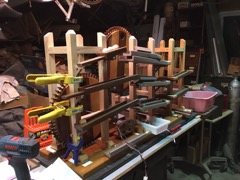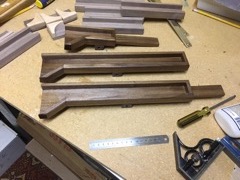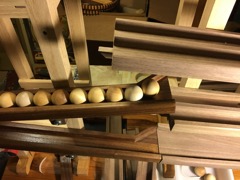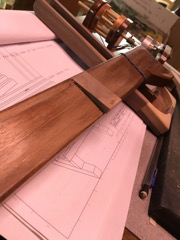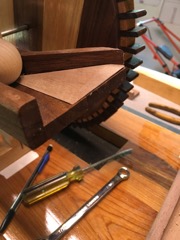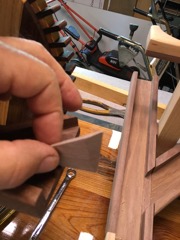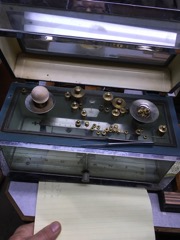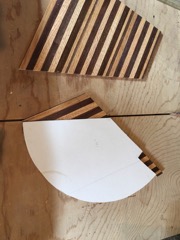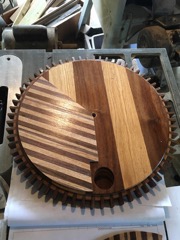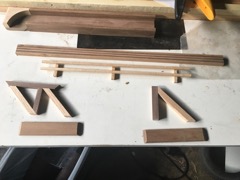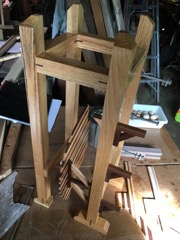More from the Treenut woodpile ....
Building a Rolling Ball Clock out of scrap wood.
June 2018 - August 2018
Check out the previous pages for this project..
This is a case of the 90/10 rule
Or as Rube Goldberg probably said -- why do it the simple way when you can think of so many that are much more interesting.
A clock is a boring thing to watch -- ask any kid at 3:15 on a school day. Even a ball clock is pretty boring to watch 99% of the time; when all that's going on is the lifting the next ball from the bottom to the top. Once you see how this is done and watch it for few minutes, what is left to marvel at? What is left to think about? Thus -- boredom -- right?. So why not make the clock interesting to look at as well as interesting to watch?
At this stage I spend a lot of time -- read HUGE amount of time -- moving balls from bottom to top and watching them fill each of the time racks. Make sure they flow easily and reliably from step to step without hanging up anywhere. Making sure the racks trip when they need to and that all the balls move RELIABLY to their required destination -- in their proper channel.
Adjustments must be made. Improvements must be devised and crafted.
This is where the plans fall short. It is to be expected. I knew it was coming and I prepared for it by keeping all my options open up to this point. (mainly that means nothing is glued down until I am sure it works properly in it's place and of it's design.
Getting all the 'ducks' in a row
Once I mounted the teter-totter time ramps on their pivots and started running balls down the loading ramps, I realized that there are two lanes that the balls have to run in: the long front lane where they line up to tell the time, and the short rear lane at the very end where the last ball falls and causes the ramp to teeter and dump.
It is critical that the balls stay in their own lanes so that when the ramp dumps the correct balls will go into the correct lanes in the exit ramps.
This is what happens most of the time when the next to last ball settles half way between lanes.
When the last ball comes in there isn't enough room for it in the back lane so it hangs out over the end of the ramp and when the ramp tips it jams and all things stop.
What to do? ....
First try (wedge):
Tipping the Time Ramp towards the front may force all the balls into the front lane (that last one is the most important one, of course it's not a problem for the others).
I sliced a piece of wood at a 4 degree angle and fastened a piece to the bottom of the ramp (double stick tape - I'm tired of prying off glue joints). I then mounted it on the pivot.
Long story short; this didn't work. It messed up the alignment with the other ramps and the last ball still settled half-way most of the time. Hard to believe, I know.
I even tried a piece of wood sliced at a 2 degree angle to no avail.
Second try (ball guide):
Sometimes the more direct approach is the most effective.
Again I sliced an angled piece of wood (~2 degree). But this time I mounted it in the real lane. This forced even the last ball into the front lane.
This seems to work - so far. I still had to file down the edge at the end or else that 'trip' ball would hang up on the wedge and would not dump. (it's always something)
A question of balance:
In the process of rolling balls down through the clock by hand I noticed that sometimes the last ball failed to tip the balance on one or two of the time ramps. Since this didn't happen every time, maybe the balls aren't of uniform weight.
I weighed a random sampling of 12 balls, found the mean and standard deviation.
I then checked all the balls and removed any that were at least plus or minus one standard deviation from the mean. (5 balls were removed out of 50)
Weights in gms:
| Mean | 7.62 |
| SD | 0.44 |
| Max | 8.32 |
| Min | 6.82 |
That seemed to help but I'm not convinced that the ramps should be so sensitive. I'll revisit this when the ramps are all permanently attached.
Ball Retainers:
Even though the hole in this wheel drilled at an angle, the ball will roll out as the hole rotates to the top. So some sort of retainer needs to hold the ball in until we want it to drop.
The design calls for a thin piece of wood cut in a semi-circle.
I spiced this up a bit.
I glued up some red oak and black walnut strips, sliced off 4mm strips and glued them together to make the striped stock.
I actually did this more to minimize warping of this thin piece, but I think it looks nice too.
The plans don't say anything about how to mount this retainer in the clock, which leaves me maximum 'artistic license'.
From the pictures of their clock it looks like they just fastened these retainers to the ball tracks. This is probably sufficient but -- once again -- I won't let 'sufficient' be sufficient when there is room for some engineering flourish.
The bottom picture shows the retainer laying against the ball wheel to show the relationship between the two.
Mounting for Ball Retainers:
This picture shows the glue-up for the ball retainer mounting brackets. It also shows the 'fence' pieces I added to the down ramps to keep the balls from bouncing out after they clear the corners. (In 'future' models I will make the corner pieces slightly higher).
The bottom picture shows the final mounting of the ball retainer. This is plenty sturdy for the purpose.
You can also see the pivot stops for the ball holders (teeter-totter). I dressed these up a bit as well.
